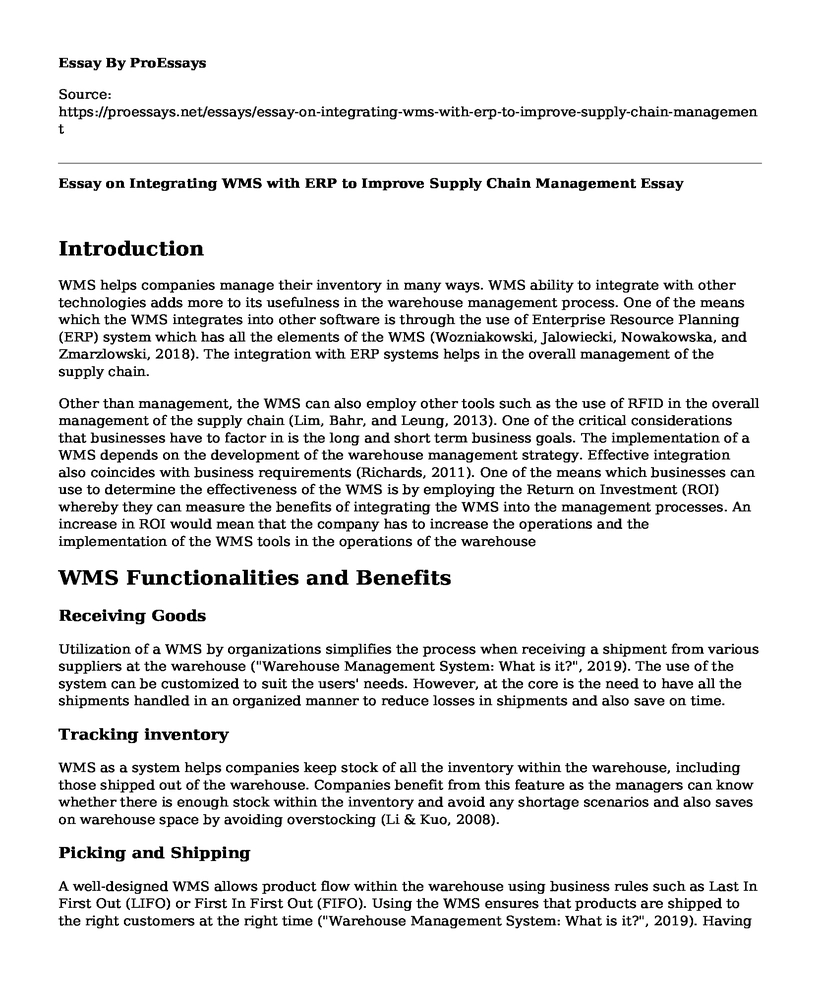Introduction
WMS helps companies manage their inventory in many ways. WMS ability to integrate with other technologies adds more to its usefulness in the warehouse management process. One of the means which the WMS integrates into other software is through the use of Enterprise Resource Planning (ERP) system which has all the elements of the WMS (Wozniakowski, Jalowiecki, Nowakowska, and Zmarzlowski, 2018). The integration with ERP systems helps in the overall management of the supply chain.
Other than management, the WMS can also employ other tools such as the use of RFID in the overall management of the supply chain (Lim, Bahr, and Leung, 2013). One of the critical considerations that businesses have to factor in is the long and short term business goals. The implementation of a WMS depends on the development of the warehouse management strategy. Effective integration also coincides with business requirements (Richards, 2011). One of the means which businesses can use to determine the effectiveness of the WMS is by employing the Return on Investment (ROI) whereby they can measure the benefits of integrating the WMS into the management processes. An increase in ROI would mean that the company has to increase the operations and the implementation of the WMS tools in the operations of the warehouse
WMS Functionalities and Benefits
Receiving Goods
Utilization of a WMS by organizations simplifies the process when receiving a shipment from various suppliers at the warehouse ("Warehouse Management System: What is it?", 2019). The use of the system can be customized to suit the users' needs. However, at the core is the need to have all the shipments handled in an organized manner to reduce losses in shipments and also save on time.
Tracking inventory
WMS as a system helps companies keep stock of all the inventory within the warehouse, including those shipped out of the warehouse. Companies benefit from this feature as the managers can know whether there is enough stock within the inventory and avoid any shortage scenarios and also saves on warehouse space by avoiding overstocking (Li & Kuo, 2008).
Picking and Shipping
A well-designed WMS allows product flow within the warehouse using business rules such as Last In First Out (LIFO) or First In First Out (FIFO). Using the WMS ensures that products are shipped to the right customers at the right time ("Warehouse Management System: What is it?", 2019). Having the accuracy in shipment means that the company can avoid unnecessary losses and shipment costs.
Tracking and Visibility
WMS comes in handy, especially to companies that require efficient tracking capabilities. A WMS at is core has features that track serial numbers from products, including vital data such as expiry dates ("Warehouse Management System: What is it?", 2019). With each data point comes additional costs for maintenance. However, companies can benefit in the long run having an efficient system that ensures that products stored in the warehouse are of quality and limited product recalls.
Conclusion
WMS plays a vital role in the development and management of warehouses. The system employs various tools such as RFIDs to help in tracking shipments and inventory within the warehouse. The result is increased effectiveness within the organizations as there are reduced costs in maintaining legacy systems and also saves on time spent in tracking inventory within the warehouse. Overall the system offers more benefits to the organization using WMS.
References
Li, S. G., & Kuo, X. (2008). The inventory management system for automobile spare parts in a central warehouse. Expert Systems with Applications, 34(2), 1144-1153.
Lim, M. K., Bahr, W., & Leung, S. C. (2013). RFID in the warehouse: A literature analysis (1995-2010) of its applications, benefits, challenges and future trends. International Journal of Production Economics,145(1), 409-430. doi:10.1016/j.ijpe.2013.05.006
Richards, G. (2011). Warehouse Management: A Complete Guide to Improving Efficiency and Minimizing Costs in the Modern Warehouse. UK: Kogan Page Ltd.
Warehouse Management System: What is it?. (2019). Retrieved from https://www.qstockinventory.com/blog/warehouse-management-system/
Wozniakowski, T., Jalowiecki, P., Nowakowska, M., & Zmarzlowski, K. (2018). Erp Systems And Warehouse Management By Wms. Information System in Management,7(2), 141-152. doi:10.22630/isim.2018.7.2.13
Cite this page
Essay on Integrating WMS with ERP to Improve Supply Chain Management. (2023, Jan 16). Retrieved from https://proessays.net/essays/essay-on-integrating-wms-with-erp-to-improve-supply-chain-management
If you are the original author of this essay and no longer wish to have it published on the ProEssays website, please click below to request its removal:
- A Business Plan for a Breakfast Restaurant Paper Example
- The Future of Nursing: Leading Change, Advancing Health Essay
- Essay Sample on Leadership and Leadership Styles
- Issues Analysis and Theoretical Approaches to Leading the Change Paper Example
- Essay Sample on the Perils of Bad Strategy
- Essay Example on Paul Violates Federal Security Laws: Disclosure Requirements Not Met
- Positive Model for Organizational Growth: Exploring Its Benefits - Essay Sample







